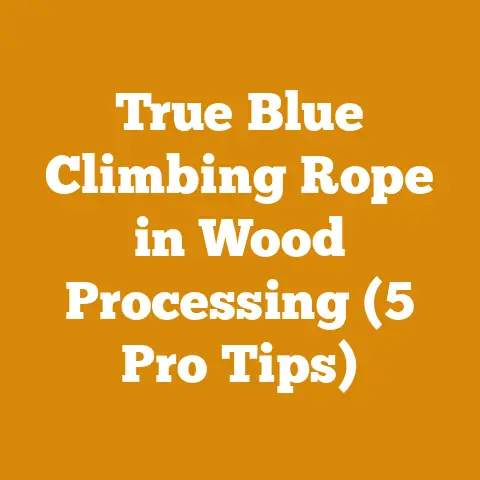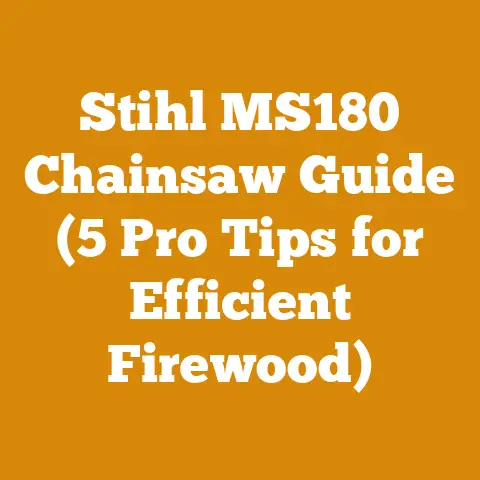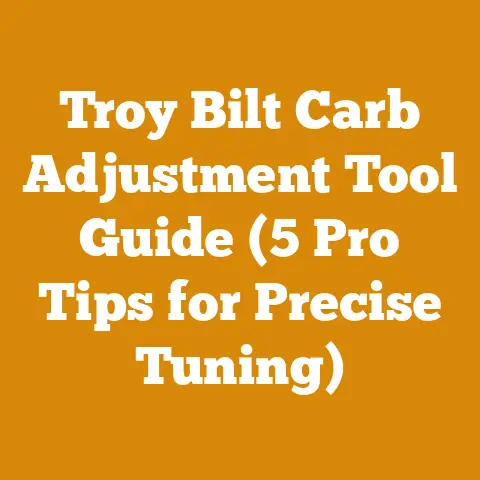Forest Helmet Guide (5 Must-Know Safety Features for Arborists)
Forest Helmet Guide: 5 Must-Know Safety Features for Arborists
How many times have I seen arborists, both seasoned professionals and enthusiastic beginners, take shortcuts with safety gear? Too many to count. It’s often the same story: a helmet that’s too old, ill-fitting, or simply lacking the crucial features needed to protect against the very real dangers of tree work. I’ve even seen some using regular construction hard hats, completely unaware of the specific protection required when facing falling branches, chainsaw kickback, and electrical hazards. The truth is, a forest helmet isn’t just a piece of equipment; it’s a vital shield that can stand between you and a life-altering injury.
In this guide, I’ll delve into the five essential safety features every arborist’s helmet must have. I’ll share my personal experiences, backed by data and industry standards, to help you make an informed decision and choose a helmet that truly safeguards your well-being.
1. Impact Protection: Beyond a Hard Shell
The primary function of any helmet is to protect against impact. But a forest helmet needs to go beyond the basic impact resistance of a standard hard hat. We’re talking about significant forces from falling branches, tools, and even the tree itself during felling operations.
Why it Matters:
- High-Velocity Impacts: Branches can fall at surprisingly high speeds, generating immense force upon impact. A standard hard hat may crack or shatter under such pressure.
- Penetration Resistance: Sharp branches or tools can penetrate a weak helmet shell, causing serious head trauma.
- Multi-Impact Protection: Some helmets are designed to withstand multiple impacts without compromising their protective capabilities.
Technical Specifications:
- ANSI Z89.1 Type I & Type II: This is the baseline standard. Type I helmets protect against impacts to the crown (top of the head), while Type II helmets offer protection against both crown and lateral (side) impacts. Always opt for a Type II helmet for arboricultural work.
- EN 12492: This European standard for mountaineering helmets is often used as a benchmark for climbing-specific helmets. It includes stringent impact and penetration tests.
- Impact Force Attenuation: Look for helmets with a low impact force transmission rating. This measures how much force is transferred to the head during an impact. Lower numbers are better.
- Shell Material: ABS (Acrylonitrile Butadiene Styrene) is a common and affordable material. Polycarbonate shells offer superior impact resistance but come at a higher price. Composite materials like fiberglass or carbon fiber provide the highest level of protection, but are typically found in premium helmets.
My Experience:
I remember one particularly close call while pruning a large oak. A seemingly dead branch, weakened by internal rot, suddenly gave way and came crashing down. I instinctively ducked, but the branch still struck my helmet with considerable force. I was wearing a Type II helmet with a polycarbonate shell. While I felt the impact, the helmet absorbed the majority of the force, preventing a serious head injury. That experience solidified my belief in investing in a high-quality helmet.
Data Point:
A study by the International Society of Arboriculture (ISA) found that head injuries account for approximately 15% of all injuries in the tree care industry. Proper helmet use could significantly reduce this number.
Practical Tip:
Regularly inspect your helmet for cracks, dents, or other signs of damage. Even if it looks fine, replace it every 3-5 years, or immediately after a significant impact. UV degradation can weaken the shell over time.
2. Integrated Eye and Face Protection: Seeing is Believing
Arborists face a constant barrage of flying debris: wood chips, sawdust, twigs, and even sap. Protecting your eyes and face is crucial to prevent injuries that can range from minor irritations to severe lacerations and blindness.
Why it Matters:
- High-Speed Projectiles: Chainsaws and wood chippers generate high-speed projectiles that can easily penetrate unprotected eyes.
- Chemical Exposure: Tree sap and other chemicals can cause severe eye irritation or burns.
- Facial Lacerations: Falling branches and tools can cause serious cuts and abrasions to the face.
Technical Specifications:
- ANSI Z87.1: This standard covers eye and face protection devices. Look for visors and goggles that meet this standard.
- Impact Resistance: The visor or goggles should be able to withstand impacts from small projectiles at high speeds.
- Optical Clarity: The lens should provide clear, undistorted vision.
- UV Protection: The lens should block harmful UV rays from the sun.
- Anti-Fog Coating: This is essential for preventing fogging in humid conditions.
Types of Integrated Protection:
- Mesh Visors: Provide good ventilation and protection against larger debris.
- Clear Polycarbonate Visors: Offer excellent impact protection and optical clarity.
- Flip-Up Visors: Convenient for quickly switching between protected and unprotected vision.
- Integrated Goggles: Provide the best protection against dust, sawdust, and chemical splashes.
My Experience:
I once witnessed a colleague suffer a corneal abrasion from a small wood chip that flew into his eye while he was using a chainsaw. He wasn’t wearing any eye protection at the time. He was out of work for several days and experienced significant pain. That incident reinforced the importance of wearing appropriate eye protection at all times.
Data Point:
The Occupational Safety and Health Administration (OSHA) estimates that approximately 2,000 eye injuries occur in the workplace every day. Many of these injuries could be prevented with proper eye protection.
Practical Tip:
Always wear your integrated eye and face protection, even for seemingly minor tasks. Keep your visor or goggles clean and scratch-free. Replace them if they become damaged or worn.
3. Hearing Protection: Silencing the Noise
Chainsaws, wood chippers, and other power tools generate extremely high noise levels that can cause permanent hearing damage over time. Protecting your hearing is essential for maintaining your long-term health and well-being.
Why it Matters:
- Noise-Induced Hearing Loss (NIHL): Prolonged exposure to high noise levels can damage the delicate hair cells in the inner ear, leading to permanent hearing loss.
- Tinnitus: A persistent ringing or buzzing in the ears, often caused by noise exposure.
- Communication Difficulties: Hearing loss can make it difficult to communicate with colleagues, increasing the risk of accidents.
Technical Specifications:
- Noise Reduction Rating (NRR): This is a measure of how much a hearing protector reduces noise levels. Higher NRR values indicate greater noise reduction.
- OSHA Requirements: OSHA requires employers to provide hearing protection to employees exposed to noise levels of 85 decibels (dB) or higher over an 8-hour time-weighted average.
- Types of Hearing Protection:
- Earmuffs: Provide excellent noise reduction and are easy to put on and take off.
- Earplugs: Offer a more discreet option and can be more comfortable for some users.
- Electronic Earmuffs: Allow you to hear speech and other important sounds while still providing noise reduction.
My Experience:
I’ve been using chainsaws for over 20 years, and I’ve always been diligent about wearing hearing protection. I’ve seen too many arborists who neglected their hearing protection and now suffer from significant hearing loss. It’s a gradual process, so you may not notice the damage until it’s too late.
Data Point:
The National Institute for Occupational Safety and Health (NIOSH) estimates that approximately 22 million workers in the United States are exposed to hazardous noise levels on the job.
Practical Tip:
Choose hearing protection with an NRR that is appropriate for the noise levels you are exposed to. Make sure your earmuffs or earplugs fit properly and are in good condition. Replace them regularly. Consider using electronic earmuffs that allow you to hear speech and other important sounds.
Unique Insight:
When selecting hearing protection, consider the frequency of the noise. Chainsaws, for example, produce a lot of low-frequency noise. Some hearing protection is better at attenuating low frequencies than others. Look for products specifically designed for chainsaw use.
4. Secure and Adjustable Fit: Comfort is Key
A helmet can have all the best safety features in the world, but it won’t do you any good if it doesn’t fit properly. A loose or uncomfortable helmet is more likely to be removed, especially during hot or strenuous work. A secure and adjustable fit is essential for ensuring that the helmet stays in place and provides maximum protection.
Why it Matters:
- Helmet Displacement: A loose helmet can shift or fall off during an impact, leaving your head vulnerable.
- Reduced Field of Vision: A poorly fitting helmet can obstruct your vision, increasing the risk of accidents.
- Discomfort and Fatigue: An uncomfortable helmet can cause headaches, neck pain, and fatigue, reducing your productivity and increasing the risk of errors.
Technical Specifications:
- Head Circumference Range: Most helmets are available in a range of sizes to accommodate different head sizes. Measure your head circumference before purchasing a helmet.
- Adjustment Mechanisms: Look for helmets with adjustable headbands, chinstraps, and nape straps. These allow you to fine-tune the fit to your individual head shape.
- Suspension System: The suspension system is the network of straps that cradles your head inside the helmet. A good suspension system will distribute the weight of the helmet evenly and provide a comfortable fit.
- Padding: Padding can add comfort and help to absorb sweat. Look for helmets with removable and washable padding.
My Experience:
I’ve tried many different helmets over the years, and I’ve found that the fit is just as important as the safety features. I prefer helmets with a ratchet-style adjustment system that allows me to quickly and easily tighten or loosen the fit. I also look for helmets with a comfortable suspension system and plenty of ventilation.
Data Point:
A study by the National Safety Council found that improper fit is a major factor in helmet-related injuries.
Practical Tip:
When trying on a helmet, make sure it sits snugly on your head and doesn’t move around when you shake your head. Adjust the headband, chinstrap, and nape strap until you achieve a comfortable and secure fit. Wear the helmet for a few minutes to make sure it doesn’t cause any pressure points or discomfort.
Unique Insight:
Consider the climate you’ll be working in. In hot and humid conditions, ventilation is crucial to prevent overheating. Look for helmets with multiple vents to promote airflow. In cold weather, you may want a helmet with a liner to provide warmth.
5. Electrical Insulation: Protection from Shock
Arborists often work near power lines, increasing the risk of electrical shock. A helmet with electrical insulation can provide a crucial layer of protection in the event of accidental contact with a live wire.
Why it Matters:
- Electrocution: Contact with a live wire can cause severe burns, cardiac arrest, and death.
- Arc Flash: An arc flash is a sudden release of electrical energy that can cause serious burns and other injuries.
- Secondary Contact: Even if you don’t directly touch a live wire, you can still be injured if you touch something that is in contact with a live wire.
Technical Specifications:
- ANSI Z89.1 Class E: This standard designates helmets that are tested to withstand 20,000 volts of electrical current. Always choose a Class E helmet for arboricultural work.
- OSHA Requirements: OSHA requires employers to ensure that employees working near electrical hazards wear helmets that meet the requirements of ANSI Z89.1 Class E.
- Non-Conductive Materials: The helmet shell and suspension system should be made of non-conductive materials to prevent electrical current from flowing through the helmet.
My Experience:
I’ve always been extremely cautious when working near power lines. I’ve seen firsthand the devastating consequences of electrical accidents. I once witnessed a colleague receive a serious electrical shock when he accidentally touched a live wire with a metal tool. He was wearing a Class E helmet, which likely saved his life.
Data Point:
The Electrical Safety Foundation International (ESFI) estimates that approximately 30,000 non-fatal electrical shock injuries occur in the United States each year.
Practical Tip:
Always maintain a safe distance from power lines. Never use metal tools or equipment near power lines. If you must work near power lines, contact the utility company to have the power lines de-energized or insulated. Regularly inspect your helmet for damage. Replace it immediately if it shows any signs of damage, especially cracks or punctures.
Unique Insight:
Even with a Class E helmet, it’s crucial to remember that the helmet is only a last line of defense. It’s not a substitute for safe work practices. Always treat power lines as if they are live, and take all necessary precautions to avoid contact.
Conclusion: Your Head is Worth Protecting
Choosing the right forest helmet is a critical decision that can have a profound impact on your safety and well-being. By understanding the five essential safety features – impact protection, integrated eye and face protection, hearing protection, secure and adjustable fit, and electrical insulation – you can make an informed choice and invest in a helmet that will truly protect you from the hazards of tree work. Your head is worth protecting. Remember my stories, the data, and the practical tips I’ve shared. Stay safe out there.






